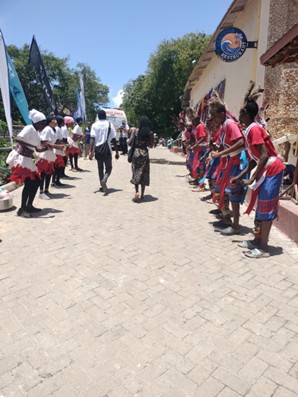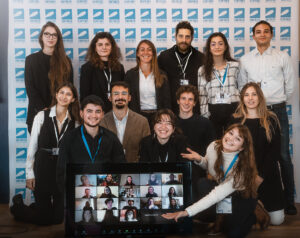Written by Jentrix Chochy Sakwa, ODHN Regional Representative – Western Indian Ocean/East African Region.
Featureed image: Photo captured by Jentrix Chochy showcasing the main stage of the TEAOF celebration, where performances and cultural presentations took center stage.
The East African Ocean Festival (TEAOF) returned for its second year in vibrant style, running from 9 – 11 October 2025 along the historic waters of Tudor Creek in Mombasa, Kenya. The festival built on its 2024 debut and again spotlighted the region’s maritime heritage, cultural unity, ocean sports, and environmental awareness.
Held at Tudor Creek, a key maritime route historically used by traders accessing the East African mainland, the festival aimed to reinforce the link between coastal communities, their ocean cultures and the livelihoods shaped by the sea. Over the three days, TEAOF featured a rich array of activities: traditional dhow racing, kayaking and canoe race competitions, a boat and show parade, jet-ski racing, and a traditional music competition.
Cultural exhibitions and marine-heritage displays ran side-by-side with ocean-sport thrills, reflecting the festival’s dual focus on celebration and awareness

Photo captured by Jentrix Chochy at the entrance of the main festival gate, highlighting the rich Intangible Cultural Heritage of the Digo, Duruma, and Mijikenda communities through their traditional songs and vibrant attire.
Through the collaboration with the National Museums of Kenya (NMK), attendees explored a photographic exhibition on Maritime and Underwater Cultural Heritage (MUCH) in Kenya, highlighting submerged shipwrecks, coastal heritage sites and intangible maritime traditions of Kenya’s coastal communities. The exhibition sought to engage the public, deepen understanding of ocean heritage and broaden awareness of how heritage and livelihoods connect.
The event was free and open to the public, attracting different organizations, age groups, minority groups, and political class among others. Educating the public on the “wonders of submerged heritage” was the aim of the exhibition, as different groups got immersed in learning about UCH, future opportunities in the field and how this heritage will shape the country’s economy at large.

Jentrix Chochy guides event organizer Mr. Mwaguya and his colleagues through the exhibition, showcasing a collection of captivating photographs.

Secondary school students engage in a learning session on Kenya’s Underwater Cultural Heritage (UCH), exploring potential career paths in maritime and heritage-related fields.
Some of the outcomes that emerged from the exhibition entailed:
- The festival offered a wonderful opportunity to shed light on Kenya’s rich Maritime and Underwater Cultural Heritage (MUCH). Many visitors expressed a shared sentiment: that future exhibitions should go beyond photography and embrace more interactive experiences. Suggestions such as incorporating virtual reality (VR) stood out, allowing audiences to explore underwater sites virtually, and giving those who can scuba dive, snorkel, or free dive a chance to interact directly with these remarkable heritage sites.
- An equally exciting outcome was the growing curiosity among young learners, from primary to university level, who showed keen interest in pursuing careers within this emerging field. I was delighted to introduce them to the wide range of disciplines that form the backbone of MUCH: cultural anthropology, underwater archaeology, conservation, scuba diving, underwater photography, and more.
- It was truly inspiring to see schoolchildren so eager to be part of this conversation. Many even suggested that maritime heritage studies should be integrated into school curricula, especially in coastal regions, to foster ocean awareness and conservation from an early age.
- Maritime and Underwater Cultural Heritage remains a new but vital conversation for the Kenyan public. Hosting more festivals and community-driven events like this will not only raise awareness but also deepen our collective appreciation of the ocean as a living archive of culture, memory, and identity. The more we connect with our maritime past, the better we can protect it for the generations yet to come.
In conclusion, the festival also incorporated environmental and economic-cultural themes: beach clean-ups were organized; discussions and displays raised awareness of ocean health and its influence on coastal tourism and heritage. A further objective was to increase Mombasa’s visibility not just as a coastal city but as a dynamic water-space destination with rich blue-economy potential.
The indicent
However, the 2025 edition of EAOF was overshadowed by a tragic accident. On the evening of Friday 10 October, during a dragon-boat race at Tudor Creek, a boat carrying 22-23 participants capsized near the finish line. Nineteen participants were rescued, while three people were initially missing and later confirmed deceased. In response, the festival’s organizing committee formally suspended all further activities of the event to allow rescue and recovery operations to proceed uninterrupted. The Mombasa County government announced an investigation into the incident, highlighting that the organizing body had not obtained required permits for the event and citing safety-protocol lapses (such as lack of life jackets or properly inspected vessels). Governor Abdulswamad Shariff Nassir announced new county-wide regulations: future marine-sport events must secure clearance from the County Security Committee and Disaster Management Unit; vessels must be inspected, life-jackets mandatory and a dedicated rescue-fleet established (Capital FM, nd.2025).
The accident inevitably cast a shadow over the festival’s aspirations. While the original program had celebrated sports, culture and heritage, the suspension of activities curtailed the planned closing ceremonies, awards and some side-events. The incident also directed attention to the urgent need for improved safety standards, emergency preparedness, and regulatory oversight in ocean heritage and sport festivals across the region.
In conclusion, though the festival was marked by tragedy, its deeper purpose shone through; it became a powerful reminder of why we must continue to celebrate and protect our maritime heritage. The event offered a vital platform to showcase the richness of our ocean cultures, strengthen ocean literacy, and bring coastal communities together in pride and unity. It reaffirmed that our maritime identity is not just history; it’s a living heritage that connects generations and sustains our sense of belonging.
As we look to the future, it is crucial that safety, regulations, and risk management take center stage in all ocean-based events. Only by doing so can we truly honor the drive for sustainable maritime and underwater cultural heritage, ensuring that such initiatives continue without loss or regret.
By embracing these lessons, future editions of EAOF can stand as beacons of resilience, celebrating East Africa’s maritime traditions while safeguarding the wellbeing of all participants and communities. Mombasa, with its timeless seafaring legacy, continues to rise as a symbol of sustainable blue tourism and a proud guardian of our shared ocean heritage.
Reference
https://www.capitalfm.co.ke/news/2025/10/mombasa-rolls-out-mandatory-watersports-safety-checks-after-ocean-festival-tragedy/? Retrieved on 23rd October 2025.




